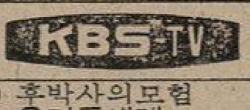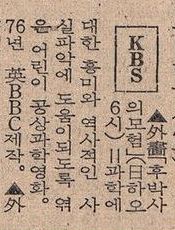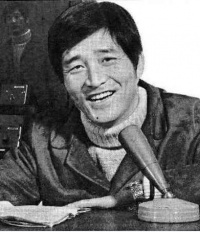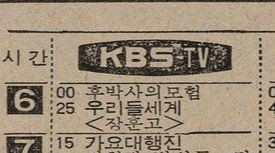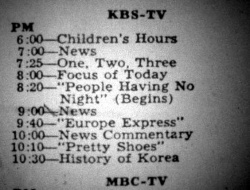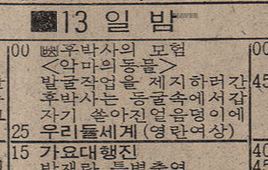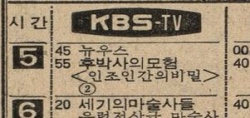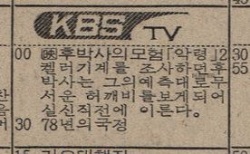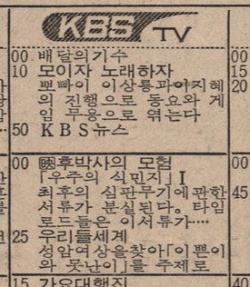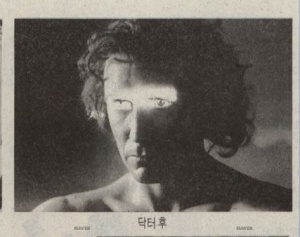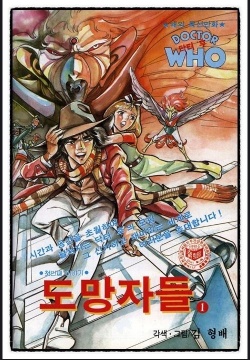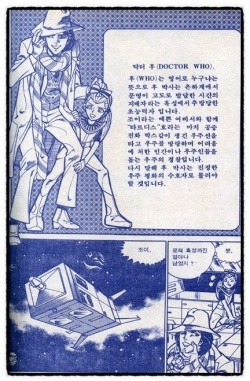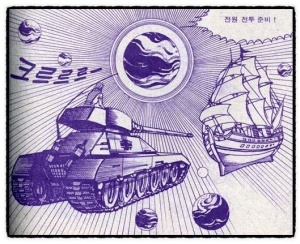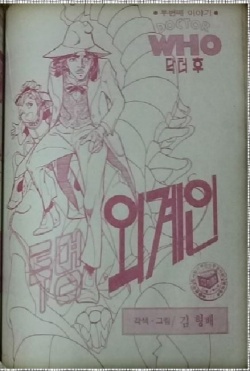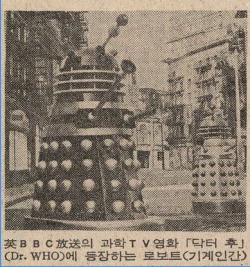Difference between revisions of "Korea (South)"
Jon Preddle (talk | contribs) |
Jon Preddle (talk | contribs) |
||
| (8 intermediate revisions by 2 users not shown) | |||
| Line 1: | Line 1: | ||
| − | The '''[[Wikipedia:Republic of Korea|REPUBLIC OF KOREA]] (aka South Korea)''' is located in [[:Category:Australasia/Asia| | + | The '''[[Wikipedia:Republic of Korea|REPUBLIC OF KOREA]] (aka South Korea)''' is located in [[:Category:Australasia/Asia|East Asia]]. |
{{TOC right}} | {{TOC right}} | ||
==Profile== | ==Profile== | ||
| Line 102: | Line 102: | ||
The programme was likely supplied on video tape in the NTSC format, with English soundtracks. | The programme was likely supplied on video tape in the NTSC format, with English soundtracks. | ||
| − | The tapes were either supplied directly by Time Life, or bicycled in from the [[Philippines]], where the series had concluded its run in September 1976. | + | The tapes were either supplied directly by Time-Life, or bicycled in from the [[Philippines]], where the series had concluded its run in September 1976. |
The series was dubbed, and the Korean actor who provided the voice for the third Doctor was [https://ko.wikipedia.org/wiki/%EC%B5%9C%EC%9D%91%EC%B0%AC Choi Eung Chan] (최응찬). Also known as Choi Chan Chan, he died only six years later, aged 43. | The series was dubbed, and the Korean actor who provided the voice for the third Doctor was [https://ko.wikipedia.org/wiki/%EC%B5%9C%EC%9D%91%EC%B0%AC Choi Eung Chan] (최응찬). Also known as Choi Chan Chan, he died only six years later, aged 43. | ||
*[https://namu.wiki/w/%EC%B5%9C%EC%9D%91%EC%B0%AC Choi Eung Chan profile] | *[https://namu.wiki/w/%EC%B5%9C%EC%9D%91%EC%B0%AC Choi Eung Chan profile] | ||
| + | |||
| + | According to [https://namu.wiki/w/%EC%9E%A5%EC%9C%A0%EC%A7%84 the website for actress Yu-jin Jang], she provided the voice of Sarah Jane Smith on the KBS series; however, since the stories that aired on the Korean channel featured Jo Grant and not Sarah Jane the website either has the wrong character assigned to the actress, or Yu-jin Jang did indeed provide the voice of Elisabeth Sladen just not for '''Doctor Who''' but for another production. | ||
| + | |||
| + | Roger Delgado / The Master's voice was provided by Kang-sik Lee ([https://en.namu.wiki/w/%EC%9D%B4%EA%B0%95%EC%8B%9D aka Kangsik Lee]). | ||
| Line 142: | Line 146: | ||
====Fate of the Tapes?==== | ====Fate of the Tapes?==== | ||
| − | Although these four stories were still playing in syndication on various stations around the [[United States]] during 1978, Korea was the last foreign country to screen [[The Mind of Evil]], [[Colony in Space]] and [[The Daemons]] as one-offs. The tapes were likely returned to Time Life or the BBC, or wiped for reuse. | + | Although these four stories were still playing in syndication on various stations around the [[United States]] during 1978, Korea was the last foreign country to screen [[The Mind of Evil]], [[Colony in Space]] and [[The Daemons]] as one-offs. The tapes were likely returned to Time-Life or the BBC, or wiped for reuse. |
The original undubbed tapes of [[Terror of the Autons]] were possibly sent to [[Japan]], where the serial screened six months later, in June 1978. | The original undubbed tapes of [[Terror of the Autons]] were possibly sent to [[Japan]], where the serial screened six months later, in June 1978. | ||
| Line 149: | Line 153: | ||
===[[Paul McGann stories|PAUL McGANN]]?=== | ===[[Paul McGann stories|PAUL McGANN]]?=== | ||
[[File:KoreaMcGann.JPG|right|thumb|300px|"닥터후" - Doctor Who; Kyunghyang Shinmun, 10 Jan 1997]] | [[File:KoreaMcGann.JPG|right|thumb|300px|"닥터후" - Doctor Who; Kyunghyang Shinmun, 10 Jan 1997]] | ||
| − | The '''10 January 1997''' issue of the ''Kyunghyang Shinmun'' newspaper had an article about action movies, which included a photograph of Paul McGann (with the caption '''"닥터후"''', which is the correct translation of '''Doctor Who''') and a brief synopsis for the [[TV Movie]], however it did not state that it had screened or was to screen on Korean TV; indeed, there was nothing in the TV listings of that particular issue that appeared to be for the movie. | + | The '''10 January 1997''' issue of the ''Kyunghyang Shinmun'' newspaper had an article about action movies, which included a photograph of Paul McGann (with the caption '''"닥터후"''', which is the correct translation of '''Doctor Who''') and a brief synopsis for the [[TV Movie]], however it did not state that it had screened or was to screen on Korean TV, or was out or coming out on VHS; indeed, there was nothing in the TV listings of that particular issue that appeared to be for the movie. |
| − | If the TV Movie didn't screen, it wasn't until the arrival of the [[NEW SERIES|New Series]] on KBS2 in '''June 2005''' that '''Doctor Who''' was seen again in Korea… | + | If the [[TV Movie]] didn't screen or get released on tape, it wasn't until the arrival of the [[NEW SERIES|New Series]] on KBS2 in '''June 2005''' that '''Doctor Who''' was seen again in Korea… |
{{clear}} | {{clear}} | ||
| Line 160: | Line 164: | ||
In the '''February, March and April 1984''' issues (numbered '''17,18,19''') there was a strip based on '''Doctor Who''', written and drawn by the highly-regarded Korean artist, Kim Hyung Bae ([https://namu.wiki/w/%EA%B9%80%ED%98%95%EB%B0%B0 김형배]). It featured a [[Wikipedia:Manhwa|Manhwa]] version of the fourth Doctor who travels with a girl called Joy in the TARDIS - which has fins and flies like a rocket! | In the '''February, March and April 1984''' issues (numbered '''17,18,19''') there was a strip based on '''Doctor Who''', written and drawn by the highly-regarded Korean artist, Kim Hyung Bae ([https://namu.wiki/w/%EA%B9%80%ED%98%95%EB%B0%B0 김형배]). It featured a [[Wikipedia:Manhwa|Manhwa]] version of the fourth Doctor who travels with a girl called Joy in the TARDIS - which has fins and flies like a rocket! | ||
| − | The first | + | The first of this unlicensed work was a two-parter called '''"도망자들"''' '''("Fugitives")''' (on pages 11-55 of the February and March issues), which has the Doctor and Joy captured by birdlike aliens who have also time-scooped a Nazi tank and a British pirate ship. The three temporally-displaced groups are forced to battle each other in outer space, with the ultimate winner being allowed to go free. |
Just the idea of Nazi tanks battling pirate ships in space for the entertainment of alien birds is something that could only be in a Manhwa comic! | Just the idea of Nazi tanks battling pirate ships in space for the entertainment of alien birds is something that could only be in a Manhwa comic! | ||
| − | The third strip was '''" | + | The third strip was '''"투명 외계인"''' (which translates best as '''"Transparent Alien"'''), a single-part story in the March 1984 issue (pages 393-440). But other than the first page depicting the lobster-like creature of the title (see below), we have little information about this strip. |
Tom Baker's Doctor would have been an unknown entity in South Korea when this comic was published (the short run of Baker "movies" on [[AFRTS]] station '''AFKN''' in South Korea didn't commence until 1986), so it's not clear how Kim Hyung Bae would have known about the series. | Tom Baker's Doctor would have been an unknown entity in South Korea when this comic was published (the short run of Baker "movies" on [[AFRTS]] station '''AFKN''' in South Korea didn't commence until 1986), so it's not clear how Kim Hyung Bae would have known about the series. | ||
| Line 218: | Line 222: | ||
We also looked at the English ''Korean Times'', but for some odd reason the listings between 5.50pm (News) and 6.25pm - when '''Doctor Who''' was on - were missing. Is that because the programme wasn't in English? | We also looked at the English ''Korean Times'', but for some odd reason the listings between 5.50pm (News) and 6.25pm - when '''Doctor Who''' was on - were missing. Is that because the programme wasn't in English? | ||
| + | |||
| + | |||
| + | ==South Korea in Doctor Who== | ||
| + | *In late 1963, William Russell, Jacqueline Hill and Carole Ann Ford posed for a series of publicity photos in a school classroom set. Pinned to the wall behind them is a map of the Korean peninsula. | ||
| + | *The 1988 Summer Olympics were held in Seoul; to accommodate the live coverage from the event, the BBC's TV schedules had to be adjusted, which meant the original running order of the four Season 25 serials had to be altered to ensure that [[Silver Nemesis]] part 1 could be broadcast on 23 November 1988. | ||
Latest revision as of 20:42, 31 October 2024
The REPUBLIC OF KOREA (aka South Korea) is located in East Asia.
Contents |
Profile
| Country Number (53) | 1977 | SECOND WAVE |
| Region | Australasia/Asia | |
| Television commenced | 1956 | |
| Colour System | 1975 | NTSC |
| Population | 1977 | 34.3 million |
| TV Sets | 1977 | 3.1 million |
| Language/s | Korean | Dubbed and Subtitled |
Television Stations / Channels
The Republic of Korea began its television service on 12 May 1956. The independent station was sold to the Korean Broadcasting System (KBS) in 1961. It transmitted in Seoul (on channel 9); Pusan (ch 9); Taegu (ch 8); Taejon (ch 4); Kwangju (ch 7); Ulsan (ch 5) and Wonju (ch 12).
By the mid-1970s, the country had three other TV stations.
The KBS underwent a major reorganisation in late 1977. As part of this restructure, the channel acquired more foreign programming - it was under this new policy that Doctor Who screened.
In 1986, a run of Tom Baker stories was available on US military bases in South Korea via the American Armed Forces Network channel AFKN – see the separate profile for that station.
DOCTOR WHO IN SOUTH KOREA
South Korea was about the 53rd country to screen Doctor Who, and the eighth in Australasia/Asia (see Selling Doctor Who).
Although the series title becomes 닥터 후 in Korean script, for the episodes shown in 1977 and 1978, it was given the new title -
후박사의모험
- which translates as "Dr Hu's Adventure".
BBC Records
BBC sales paperwork indicates that the following six stories were sold and invoiced to "Korea" in this order, but also that the first three were subsequently "cancelled":
- Spearhead from Space (sold by January 1978, cancelled in April 1978)
- Doctor Who and the Silurians (sold by January 1978, cancelled in April 1978)
- The Ambassadors of Death (sold by March 1978, cancelled in April 1978)
- The Daemons (sold by April 1978)
- The Mind of Evil (sold by April 1978)
- Terror of the Autons (sold by April 1978)
While the selection of episodes does seem a bit random, it can't be a coincidence that the six serials offered to Korea were the very ones that were not purchased by the two Canadian stations TVO and CKVU in 1976/77; and the sale to Korea would have been the last prior to the seven-year sales right periods on each expiring.
It's not known why the sale/purchase of the first three stories was "cancelled"; was it KBS or the BBC who did this?
Of note, the same three stories had been purchased by Turkey in late 1977, but then "cancelled" in January 1978 - the same month that Korea purchased them. Did Korea take up the Turkey purchase, but cancel the order for the same or different reasons?
It's not likely to have been an issue with the supply of tapes since NTSC copies of all bar Spearhead from Space were still circulating around the United States at the time, or were still held by the TV station in the nearby Philippines.
In DWM, Korea is identified in the story Archive for BBB, with a sales date of 1977, based on music clearances (this date is incorrect; the music clearances were actually paid in January 1978).
In The Eighties - THE LOST CHAPTERS, records a sale of "(4)" stories to Korea Republic by 10 February 1987; these "(4)" are the four Pertwees.
The Korean equivalent of WIKIPEDIA (from which we had based our earlier version of this profile) says that the serials that aired on KBS were Doctor Who and the Silurians, Terror of the Autons, The Mind of Evil and Colony in Space; three of these are correct, but one of these titles is actually wrong, as we shall explain below.
Stories bought and broadcast
JON PERTWEE
Four stories, 21 episodes (out of order):
| JJJ | The Daemons | 5 | 악마의 동굴 | "Devil Cave" / "Cave of the Devil" |
| EEE | Terror of the Autons | 4 | 인조인간의 비밀 | "Secret of the Synthetic Humans" |
| FFF | The Mind of Evil | 6 | 악령 | "Evil Spirit" / "Spirit of Evil" |
| HHH | Colony in Space | 6 | 우주의 식민지 | "Space Colony" / "Colony in Space" |
(The translations of the Korean titles above are our own using online translation.)
Although BBC paperwork doesn't record a sale of Colony in Space to Korea, the serial did screen. With the cancellation of three stories in April, and with the clearances fees already paid for them, rather than issuing KBS with a refund, the BBC would have offered them a replacement; the clearances fees paid out for the cancelled serials therefore likely off-set the full purchase cost for Colony in Space.
Origin of the Tapes?
The programme was likely supplied on video tape in the NTSC format, with English soundtracks.
The tapes were either supplied directly by Time-Life, or bicycled in from the Philippines, where the series had concluded its run in September 1976.
The series was dubbed, and the Korean actor who provided the voice for the third Doctor was Choi Eung Chan (최응찬). Also known as Choi Chan Chan, he died only six years later, aged 43.
According to the website for actress Yu-jin Jang, she provided the voice of Sarah Jane Smith on the KBS series; however, since the stories that aired on the Korean channel featured Jo Grant and not Sarah Jane the website either has the wrong character assigned to the actress, or Yu-jin Jang did indeed provide the voice of Elisabeth Sladen just not for Doctor Who but for another production.
Roger Delgado / The Master's voice was provided by Kang-sik Lee (aka Kangsik Lee).
Transmission
JON PERTWEE
The Monday, 31 October 1977 issue of Kyunghyang Shinmun carried a story about the changes to the television service following the restructure of KBS, and amongst a preview of the forthcoming programmes is a reference to "Dr. Hu's Adventure" (Sunday 6pm), "a science fiction serial designed to give young children an interest in science and history... [made by the] BBC."
"Dr Hu's Adventure" commenced on Sunday, 6 November 1977 at 6pm (the time was always 6.00 to 6.25pm, which indicates no commercials). With the exception of two dates, the series always aired in that timeslot.
The first serial was 악마의 동굴 which best translates as "Devil Cave", or "Cave of the Devil". The Korean Wikipedia says this was Doctor Who and the Silurians -- understandable given the word "cave" in the title -- however the newspaper's synopsis for the second episode refers to the Doctor stopping an "excavation" and mentions an "icy cold blast", both being plot points from The Daemons.
Also, the numbering given to the next set of episodes, plus the two pre-emptions during the run -- reducing the episode count from 23 to 21 -- means this was a 5-parter, and not a 7-parter. The BBC records are therefore correct - the sale of Doctor Who and the Silurians had been cancelled and it therefore did not screen.
Since this is The Daemons and not The Silurians, the "cave" of the title must instead refer to the cavern beneath the church. (On reflection, the "devil" part of the title is a bit obvious!)
The second story was 인조인간의 비밀; which best translates as something along the lines of "Secret of the Synthetic Humans". Although no synopses were given, the BBC Records above says this is Terror of the Autons.
This serial started on 11 December 1977. There was no episode the following week (18 December; there was Boxing until 7.05pm instead) but part two (indicated by a (2) in the newspaper) aired on Christmas Day at the slightly earlier time of 5.55pm. There was no episode on New Year's Day, 1 January 1978. The final episode of this 4-parter aired on 15 January 1978 - indicated by a (4) in the newspaper.
Screening The Daemons before Terror of the Autons is an odd scheduling decision, since the Master is captured by UNIT in the former, and arrives on Earth for the first time in the latter! Unless the Korean dialogue was radically changed to address this..?
The following week, 22 January, the newspaper said it was episode 인조인간의 비밀 (5), but the next four weeks said 악령 parts "2" (which was listed as having a full half hour timeslot), "III", "4" and "5", so it's clear that the 22 January billing gave the wrong title, and should have been part one of 악령, which translates as "Evil Spirit", or "Spirit of Evil".
The various synopses that were printed in the next few newspapers contain references to the Keller Machine, Chin Lee, and the Master, so this is The Mind of Evil. Part 3 on 5 February aired at the later time of 6.55pm.
The fourth and final serial was 우주의 식민, which translates as "Space Colony", "Colony of Space" - or "Colony in Space". Five of the six episodes had a brief synopsis, and these contain references to the Ultimate Weapon, Dent, the Master and an alien city.
The 21 episode run (played over a 23 week period) came to an end on 9 April 1978.
Fate of the Tapes?
Although these four stories were still playing in syndication on various stations around the United States during 1978, Korea was the last foreign country to screen The Mind of Evil, Colony in Space and The Daemons as one-offs. The tapes were likely returned to Time-Life or the BBC, or wiped for reuse.
The original undubbed tapes of Terror of the Autons were possibly sent to Japan, where the serial screened six months later, in June 1978.
PAUL McGANN?
The 10 January 1997 issue of the Kyunghyang Shinmun newspaper had an article about action movies, which included a photograph of Paul McGann (with the caption "닥터후", which is the correct translation of Doctor Who) and a brief synopsis for the TV Movie, however it did not state that it had screened or was to screen on Korean TV, or was out or coming out on VHS; indeed, there was nothing in the TV listings of that particular issue that appeared to be for the movie.
If the TV Movie didn't screen or get released on tape, it wasn't until the arrival of the New Series on KBS2 in June 2005 that Doctor Who was seen again in Korea…
Merchandise
A long-running monthly comic magazine called "Treasure Island" (보물섬) published by the Yukyoung Foundation, reprinted foreign comics (such as Mad Magazine, Tintin and Marvel) as well as locally-created series in each 400+ page (!!) issue; the magazine ran from 1982 to 1992.
In the February, March and April 1984 issues (numbered 17,18,19) there was a strip based on Doctor Who, written and drawn by the highly-regarded Korean artist, Kim Hyung Bae (김형배). It featured a Manhwa version of the fourth Doctor who travels with a girl called Joy in the TARDIS - which has fins and flies like a rocket!
The first of this unlicensed work was a two-parter called "도망자들" ("Fugitives") (on pages 11-55 of the February and March issues), which has the Doctor and Joy captured by birdlike aliens who have also time-scooped a Nazi tank and a British pirate ship. The three temporally-displaced groups are forced to battle each other in outer space, with the ultimate winner being allowed to go free.
Just the idea of Nazi tanks battling pirate ships in space for the entertainment of alien birds is something that could only be in a Manhwa comic!
The third strip was "투명 외계인" (which translates best as "Transparent Alien"), a single-part story in the March 1984 issue (pages 393-440). But other than the first page depicting the lobster-like creature of the title (see below), we have little information about this strip.
Tom Baker's Doctor would have been an unknown entity in South Korea when this comic was published (the short run of Baker "movies" on AFRTS station AFKN in South Korea didn't commence until 1986), so it's not clear how Kim Hyung Bae would have known about the series.
But since Treasure Island sometimes featured material from US Marvel comics, it's possible the magazine editors or Bae himself had seen the limited series Marvel Premiere Featuring Doctor Who which reprinted material from Doctor Who Magazine; there were only four issues, published in the US between November 1980 and June 1981. Indeed, the first panel of "The Iron Legion" features a tank, and in the back pages of the US edition is 'The Five Doctors' featuring a drawing of Tom Baker which might have been Bae's sole reference for his version of the Doctor.
If anyone can shed any more light on these "Treasure Island" comic strips, please drop us a line.
TV listings
| ← AIRDATES ...... (CLICK ICON TO GO TO TABLE SHOWING EPISODE BREAKDOWN AND AIRDATES - N/S = story title is Not Stated) |
Five months prior to the series' debut on KBS, the Korean paper Dong-A Ilbo had a feature about "fearing the future", and accompanying this was a photo of two Daleks from the Peter Cushing movie "Daleks - Invasion Earth 2150 AD". The caption doesn't identify them as Daleks, just as "mechanical robots" from the BBC's "Dr. WHO."
The Korean listings came from online issues of the Kyunghyang Shinmun and Dong-A Ilbo. All but three of the billings for "Dr Hu's Adventure" gave the story title, some also had the episode's number sometimes in brackets or as Roman numerals, and on occasion the Kyunghyang also had a brief synopsis.
We also viewed the English language newspaper Korean Herald, but the 6.00 to 7.00pm timeslot simply said "Children's Hour" (or sometimes "Hours") without specifying that the first half of that hour was Doctor Who. (Like the Korean newspaper, the 19 December 1977 and 1 January 1978 papers had alternative programmes listed in the 6pm slot.)
We also looked at the English Korean Times, but for some odd reason the listings between 5.50pm (News) and 6.25pm - when Doctor Who was on - were missing. Is that because the programme wasn't in English?
South Korea in Doctor Who
- In late 1963, William Russell, Jacqueline Hill and Carole Ann Ford posed for a series of publicity photos in a school classroom set. Pinned to the wall behind them is a map of the Korean peninsula.
- The 1988 Summer Olympics were held in Seoul; to accommodate the live coverage from the event, the BBC's TV schedules had to be adjusted, which meant the original running order of the four Season 25 serials had to be altered to ensure that Silver Nemesis part 1 could be broadcast on 23 November 1988.
